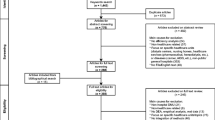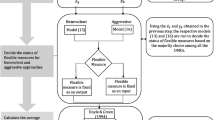Abstract
Performance measurement plays an important role in the successful design and reform of regional healthcare management systems. In this study, we propose a hybrid data envelopment analysis (DEA) and game theory model for measuring the performance and productivity in the healthcare centers. The input and output variables associated with the efficiency of the healthcare centers are identified by reviewing the relevant literature, and then used in conjunction with the internal organizational data. The selected indicators and collected data are then weighted and prioritized with the help of experts in the field. A case study is presented to demonstrate the applicability and efficacy of the proposed model. The results reveal useful information and insights on the efficiency levels of the regional healthcare centers in the case study.



Similar content being viewed by others
References
Khushalani J, Ozcan YA (2017) Are hospitals producing quality care efficiently? An analysis using dynamic network data envelopment analysis (DEA). Socio Econ Plan Sci 60:15–23. https://doi.org/10.1016/j.seps.2017.01.009
Leleu H, Al-Amin M, Rosko M, Valdmanis VG (2017) A robust analysis of hospital efficiency and factors affecting variability. Health Serv Manag Res 31(1):33–42. https://doi.org/10.1177/0951484817730537
Valdmanis VG, Rosko MD, Leleu H, Mukamel DB (2017) Assessing overall, technical, and scale efficiency among home health care agencies. Health Care Manag Sc 20:265–275. https://doi.org/10.1007/s10729-015-9351-1
Xenos P, Yfantopoulos J, Nektarios M, Polyzos N, Tinios P, Constantopoulos A (2017) Efficiency and productivity assessment of public hospitals in Greece during the crisis period 2009–2012. Cost Eff Resour Alloc 15:6. https://doi.org/10.1186/s12962-017-0068-5
Yang C-C (2017) Measuring health indicators and allocating health resources: a DEA-based approach. Health Care Manag Sc 20:365–378. https://doi.org/10.1007/s10729-016-9358-2
Toloo M, Tavana M (2017) A novel method for selecting a single efficient unit in data envelopment analysis without explicit inputs/outputs. Ann Oper Res 253:657–681. https://doi.org/10.1007/s10479-016-2375-1
Fiallos J, Patrick J, Michalowski W, Farion K (2017) Using data envelopment analysis for assessing the performance of pediatric emergency department physicians. Health Care Manag Sc 20(1):129–140. https://doi.org/10.1007/s10729-015-9344-0
Clement JP, Valdmanis VG, Bazzoli GJ, Zhao M, Chukmaitov A (2008) Is more better? An analysis of hospital outcomes and efficiency with a DEA model of output congestion. Health Care Manag Sc 11(1):67–77
Nayar P, Ozcan YA (2008) Data envelopment analysis comparison of hospital efficiency and quality. J Med Syst 32(3):193–199. https://doi.org/10.1007/s10916-007-9122-8
Palazzolo JR, Ozcan YA (2018) Do the most efficient accountable care organizations earn shared savings? Socio Econ Plan Sci 63:12–17. https://doi.org/10.1016/j.seps.2017.05.001
Büyüközkan, G., Feyzioğlu, O., & Gocer, F. (2016). Evaluation of hospital web services using intuitionistic fuzzy AHP and intuitionistic fuzzy VIKOR. Industrial Engineering and Engineering Management (IEEM), 2016 IEEE International (607–611). https://doi.org/10.1109/IEEM.2016.7797947
Cantor, V. J. M., & Poh, K. L. (2018). Integrated analysis of healthcare efficiency: a systematic review. J Med Syst, 22;42(1):8. doi: https://doi.org/10.1007/s10916-017-0848-7
Zhou L, Xu X, Antwi HA, Wang L (2017) Towards an equitable healthcare in China: evaluating the productive efficiency of community health centers in Jiangsu Province. Int J Equity Health 16:89. https://doi.org/10.1186/s12939-017-0586-y
Lai, K. K., Cheung, M. T., & Fu, Y. (2017). Resource allocation in public healthcare: a team-dea model. J Syst Sci Complex, In Press, 1–10. https://doi.org/10.1007/s11424-017-6124-6
Toloo M, Jalili R (2016) LU decomposition in DEA with an application to hospitals. Comput Econ 47(3):473–488. https://doi.org/10.1007/s10614015-9501-z
Rouyendegh, B. D., Oztekin, A., Ekong, J., & Dag, A. (2016). Measuring the efficiency of hospitals: a fully-ranking DEA–FAHP approach. Ann Oper Res, In Press, 1–18. https://doi.org/10.1007/s10479-016-2330-1
Foo CY, Lim KK, Sivasampu S, Dahian KB, Goh PP (2015) Improving the effectiveness of service delivery in the public healthcare sector: the case of ophthalmology services in Malaysia. BMC Health Serv Res 15:349. https://doi.org/10.1186/s12913-015-1011-0
Hadad S, Hadad Y, Simon-Tuval T (2013) Determinants of healthcare system’s efficiency in OECD countries. Eur J Health Econ 14(2):253–265. https://doi.org/10.1007/s10198-011-0366-3
Weng S-J, Wu T, Blackhurst J, Mackulak G (2008) An extended DEA model for hospital performance evaluation and improvement. Health Serv Outcome Res Methodol 9:39–53. https://doi.org/10.1007/s10742-008-0042-y
Ozcan YA, Khushalani J (2017) Assessing efficiency of public health and medical care provision in OECD countries after a decade of reform. CEJOR 25(2):325–343. https://doi.org/10.1007/s10100-016-0440-0
DePuccio M, Ozcan YA (2017) Exploring efficiency differences between medical home and non-medical home hospitals. Int J Healthc Manag 10(3):147–153. https://doi.org/10.1080/20479700.2015.1101913
Highfill T, Ozcan YA (2016) Productivity and quality of hospitals that joined the Medicare shared savings accountable care organization program. Int J Healthc Manag 9(3):210–217. https://doi.org/10.1179/2047971915Y.0000000020
Rezaee MJ, Izadbakhsh H, Yousefi S (2016) An improvement approach based on DEA-game theory for comparison of operational and spatial efficiencies in urban transportation systems. KSCE J Civ Eng 20:1526–1531. https://doi.org/10.1007/s12205-015-0345-9
Blake A, Carroll BT (2016) Game theory and strategy in medical training. Med Educ 50(11):1094–1106. https://doi.org/10.1111/medu.13116
Hampshire K, Hamill H, Mariwah S, Mwanga J, Amoako-Sakyi D (2017) The application of signalling theory to health-related trust problems: the example of herbal clinics in Ghana and Tanzania. Soc Sci Med 188:109–118. https://doi.org/10.1016/j.socscimed.2017.07.009
Roshanaei V, Luong C, Aleman DM, Urbach DR (2017) Collaborative operating room planning and scheduling. INFORMS J Comput 29(3):558–580. https://doi.org/10.1287/ijoc.2017.0745
Li Q, Li M, Lv L, Guo C, Lu K (2017) A new prediction model of infectious diseases with vaccination strategies based on evolutionary game theory. Chaos, Solitons Fractals 104:51–60. https://doi.org/10.1016/j.chaos.2017.07.022
Gao Y, Du Y, Sun B, Wang R, Jiang C (2017) Tripartite evolutionary game analysis on selection behavior of trans-regional hospitals and patients in telemedicine system. Int J Comput Int Sys 10(1):1132–1148. https://doi.org/10.2991/ijcis.2017.10.1.75
Wu J, Li H, Cheng S, Lin Z (2016) The promising future of healthcare services: when big data analytics meets wearable technology. Inf Manag 53(8):1020–1033. https://doi.org/10.1016/j.im.2016.07.003
Sykes D, Rychtář J (2015) A game-theoretic approach to valuating toxoplasmosis vaccination strategies. Theor Popul Biol 105:33–38. https://doi.org/10.1016/j.tpb.2015.08.003
Dakun D, Fengye H, Feng W, Zhijun W, Yu D, Lu W (2015) A game theoretic approach for inter-network interference mitigation in wireless body area networks. China Commun 12:150–161. https://doi.org/10.1109/CC.2015.7275253
Charnes A, Cooper WW, Rhodes E (1978) Measuring the efficiency of decision making units. Eur J Oper Res 2(6):429–444. https://doi.org/10.1016/0377-2217(78)90138-8
Pilyavsky AI, Aaronson WE, Bernet PM, Rosko MD, Valdmanis VG, Golubchikov MV (2006) East–west: does it make a difference to hospital efficiencies in Ukraine? Health Econ 15(11):1173–1186
Ancarani A, Di Mauro C, Giammanco MD (2009) The impact of managerial and organizational aspects on hospital wards’ efficiency: evidence from a case study. Eur J Oper Res 194(1):280–293. https://doi.org/10.1016/j.ejor.2007.11.046
Valdmanis V, Bernet P, Moises J (2010) Hospital capacity, capability, and emergency preparedness. Eur J Oper Res 207(3):1628–1634. https://doi.org/10.1016/j.ejor.2010.06.018
Sun J, Luo H (2017) Evaluation on equality and efficiency of health resources allocation and health services utilization in China. Int J Equity Health 16:127. https://doi.org/10.1186/s12939-017-0614-y
Çelik Y, Khan M, Hikmet N (2017) Achieving value for money in health: a comparative analysis of OECD countries and regional countries. Int J Health Plann Manag 32(4):e279–e298. https://doi.org/10.1002/hpm.2375
Wang M-l, Fang H-q, Tao H-b, Cheng Z-h, Lin X-j, Cai M, Xu C, Jiang S (2017) Bootstrapping data envelopment analysis of efficiency and productivity of county public hospitals in Eastern, Central, and Western China after the public hospital reform. J Huazhong Univ Sci Technolog Med Sci 37(5):681–692. https://doi.org/10.1007/s11596-017-1789-6
Villamil M d P, Barrera D, Velasco N, Bernal O, Fajardo E, Urango C, Buitrago S (2017) Strategies for the quality assessment of the health care service providers in the treatment of Gastric Cancer in Colombia. BMC Health Serv Res 17:654. https://doi.org/10.1186/s12913-017-2440-8
Ali M, Debela M, Bamud T (2017) Technical efficiency of selected hospitals in eastern Ethiopia. Heal Econ Rev 7(24):1–13. https://doi.org/10.1186/s13561-017-0161-7
Mulazzani L, Manrique R, Malorgio G (2017) The role of strategic behaviour in ecosystem service modelling: integrating Bayesian networks with game theory. Ecol Econ 141:234–244. https://doi.org/10.1016/j.ecolecon.2017.04.022
Chapman GB, Li M, Vietri J, Ibuka Y, Thomas D, Yoon H, Galvani AP (2012) Using game theory to examine incentives in influenza vaccination behavior. Psychol Sci 23(9):1008–1015. https://doi.org/10.1177/0956797612437606
Li F, Zhu Q, Liang L (2018) Allocating a fixed cost based on a DEA-game cross efficiency approach. Expert Syst Appl 96:196–207. https://doi.org/10.1016/j.eswa.2017.12.002
Lozano S (2012) Information sharing in DEA: a cooperative game theory approach. Eur J Oper Res 222(3):558–565. https://doi.org/10.1016/j.ejor.2012.05.014
Wu J, Liang L, Chen Y (2009) DEA game cross-efficiency approach to Olympic rankings. Omega 37(4):909–918. https://doi.org/10.1016/j.omega.2008.07.00
Chang R-E, Chang I-C, Chen LH, Hsieh CJ (1997) Assessing the performance of physician teams through a game theoretic approach. In: The 1997 Annual Meeting of the Decision Sciences Institute. Part 1(of 3), pp 58–60
Jahangoshai Rezaee M, Moini A, Haji-Ali Asgari F (2012) Unified performance evaluation of health centers with integrated model of data envelopment analysis and bargaining game. J Med Syst 36(6):3805–3815. https://doi.org/10.1007/s10916-012-9853-z
Cooper, W.W., Seiford, L.M. & Tone, K., 2006. Introduction to data envelopment analysis and its uses: with DEA-solver software and references. Springer Science & Business Media
Doyle J, Green R (1994) Efficiency and cross-efficiency in DEA: derivations, meanings and uses. J Oper Res Soc 45:567–578. https://doi.org/10.1057/jors.1994.84
Acknowledgements
The authors would like to thank the anonymous reviewers and the editor for their insightful comments and suggestions.
Author information
Authors and Affiliations
Corresponding author
Appendix 1
Appendix 1
Rights and permissions
About this article
Cite this article
Zare, H., Tavana, M., Mardani, A. et al. A hybrid data envelopment analysis and game theory model for performance measurement in healthcare. Health Care Manag Sci 22, 475–488 (2019). https://doi.org/10.1007/s10729-018-9456-4
Received:
Accepted:
Published:
Issue Date:
DOI: https://doi.org/10.1007/s10729-018-9456-4




